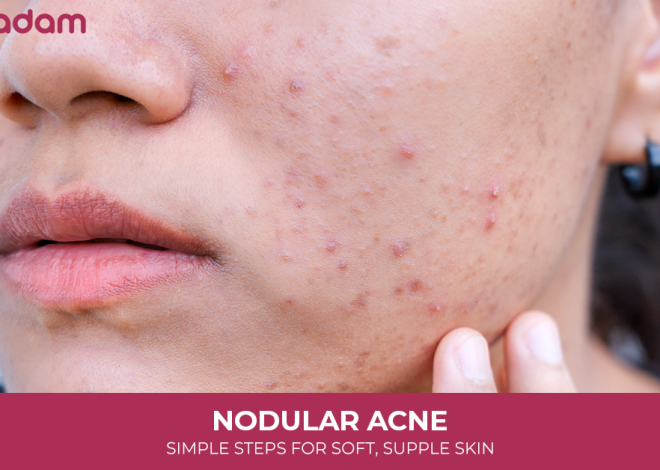
Laser for Melasma Treatment: Latest Technologies for Best Results
Melasma is an annoying cosmetic problem that generally appears on the face as gray or brown spots of discoloration or as dark patches.
It is the natural phenomenon of melanin being produced in the skin. The common factors contributing to melasma include sun exposure, hormonal changes, and genetics.
Melasma most often appears on the face and other sun-exposed areas of the skin, including the upper lip, cheeks, forehead, and chin. While topical creams can help lighten melasma, they are usually not sufficient on their own, and treatment often requires a combination of sun protection, topical agents, oral medications, or procedures such as chemical peels or laser therapy.
Read this blog on laser for melasma and explore how lasers are the most promising treatments for melasma. It also discusses the different types of laser treatments for melasma and the overall side effects of laser therapy for melasma.
More Information For You: Laser Treatment for Pimples
Table of Contents
Why Choose Laser for Melasma?
Have you tried countless skincare products or topical treatments like tranexamic acid, azelaic acid, or hydroquinone with little to no results for treating melasma? But don’t lose hope. Laser therapy is known as an effective treatment option for reducing and managing the apperance of melasma.
Patients are increasingly relying their trust on laser treatments due to the ability to provide more visible, faster results in comparison to traditional products like creams, while preventing the risks associated with oral medications too.
Melasma laser treatment has emerged as a crucial aspect of melasma management. Lasers target a larger section of the skin and target the melanin found in the skin, thereby breaking it down and enabling your body to remove it naturally. Gradually, this causes a significant decrease in the darkness of melasma patches.
Different Types of Lasers for Melasma Treatment

There are many types of lasers for melasma treatment, each with a unique set of benefits. Here are some of the commonly used lasers for addressing melasma:
Fractional lasers
This type of laser works by creating microscopic holes in your skin that aid in the growth of healthy and new skin cells. This is specifically useful for making your skin brighter and more even.
Intense pulsed light
The process converts a broad spectrum of light wavelengths into heat to directly target melasma-affected areas without any sort of damage to the surrounding skin tissue. It is best for those whose melasma is deep inside the skin as it targets the dermis (the lower skin layer), and does not target the epidermis ( the top skin surface).
Pico-second lasers
Picosecond laser is a new kind of laser technology that delivers very short pulses of energy converted to pressure -rather than heat -to destroy melanin particles and remove hyperpigmented spots without any damage to healthy surrounding tissue.
Qs nd: Yag
In this treatment, high-energy pulses of light are emitted that target the melanin production. It is particularly effective in minimizing the pigmentation of melasma patches and is beneficial for those with darker skin tones. The light energy pulses help break down the melanin particles, which are then removed by the body’s natural processes.
Alexandrite lasers
This treatment works by emitting picosecond energy bursts and more photoacoustic energy that physically shatters the melanin pigments, thereby clearing areas of hyperpigmentation caused by sunspots.
Don’t Miss: Laser Treatment for Pigmentation on Face
Complementary Treatment Options for Melasma
While the aforestated laser treatments are effective, they can prove to be more successful when combined with other therapies or skincare practices:
| Treatment options | Actions/ Tips/ Ingredients | Benefits for melasma |
| Topical lightening creams | Skin lightening ingredients like resorcinol, azelaic acid, etc | Inhibits melanin production and prevents dark spots from forming. |
| Chemical peels | Acids and other ingredients such as tretinoin. | Removes the outer layer of hyperpigmented skin through exfoliating agents, commonly used in melasma treatment. |
| Oral therapies | Tranexamic acid | Reduces melanin production if taken daily for 8-12 weeks. |
| Microneedling | Needle rollers, electric-powered pen. | Create tiny punctures to place topical melasma creams deeply and evenly on the skin surface and to reduce hyperpigmented spots. |
| Use of sunscreen and lifestyle changes | SPF broad-spectrum sunscreen, protective clothing. | These simple tips can prevent melasma from worsening. |
Melasma Laser Treatment Side Effects

Laser treatments for melasma can cause side effects, with some being more common than others.
Common laser treatment for melasma side effects
Erythema (Redness): A common reaction, similar to a sunburn, usually subsiding within a few days.
Swelling: Can occur in the treated area, also typically resolving within a short period.
Skin Irritation and Burning: Some individuals experience a burning or stinging sensation after treatment.
Post-inflammatory Hyperpigmentation (PIH): Darkening of the skin in the treated area, more common in individuals with darker skin tones.
Related Blog: Laser Treatment for Dark Spots
Less Common but More Serious Side Effects:
- Hypopigmentation: A lightening of the skin in the treated area, which can sometimes be permanent.
- Blistering: Rare, but can occur, particularly with stronger laser settings.
- Scarring: A potential risk with any laser treatment, although generally rare with melasma treatments.
- Rebound or Recurrence of Melasma: Melasma can sometimes reappear after treatment.
- Infection: Although rare, any break in the skin carries a risk of infection.
Important Considerations:
Sun Sensitivity: Treated areas are more sensitive to sunlight and require diligent sun protection.
Individual Variation: Not everyone responds to laser treatment in the same way, and some individuals may experience more side effects than others.
Choosing a Qualified Practitioner: Selecting a dermatologist or aesthetician with experience in treating melasma with lasers is crucial for minimizing risks and optimizing results.
Realistic Expectations: Laser treatment may not eliminate melasma, and multiple sessions may be needed.
Alternative Treatments: Consider exploring other melasma treatments such as topical medications, chemical peels, or microneedling, especially if you are concerned about laser side effects.
Conclusion
Melasma is a frustrating skin problem that may negatively impact a person’s confidence and self-esteem. Luckily, each type of laser for melasma can effectively reduce the appearance of hyperpigmentation and melasma lesions by targeting melanin production responsible for dark spots. To enhance results, think of merging laser therapies with other treatments like oral medications and topical creams.
FAQs
Can melasma come back after laser?
Yes, while laser treatments can effectively reduce the appearance of melasma, they don’t cure the underlying condition, and the hyperpigmentation can reappear.
How many laser sessions does it take to remove melasma?
The number of laser sessions needed to remove melasma typically ranges from 4 to 8, with treatments spaced 2-4 weeks apart.
Can laser worsen melasma?
Yes, laser treatments can potentially worsen melasma in some cases. particularly if the wrong type of laser or settings are used.
Is laser treatment for melasma painful?
No, a laser treatment for melasma is generally not considered very painful. While some patients may experience mild discomfort, it’s often described as a stinging or snapping sensation.
What to expect after laser treatment for melasma?
After laser treatment for melasma, expect some initial redness and swelling, which usually subsides within a few hours to a day.
Can laser remove pigmentation?
Yes, laser treatments can effectively reduce and remove pigmentation on the skin by targeting the excess melanin (the pigment that causes dark spots) in the skin.
What is the cost of melasma laser treatment in India?
The cost of melasma laser treatment in India can range from ₹5,000 to ₹30,000 per session, but the total cost can vary significantly based on several factors like the severity of melasma, the clinic’s reputation, etc.
What is the best laser treatment for melasma?
The most effective laser treatments for melasma are picosecond lasers and fractional non-ablative lasers, with Q-switched lasers also being a viable option.
Will insurance cover laser treatment for melasma?
No, As treatment for melasma is not considered medically necessary, most insurers will not cover the cost. If you decide to treat melasma, your dermatologist will create a treatment plan tailored to your needs.
How to permanently remove melasma?
Melasma, a common skin condition causing brown or gray-brown patches, can be difficult to treat and may not be permanently cured.



